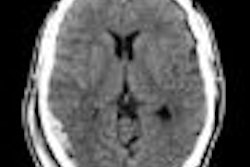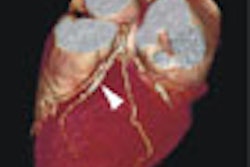VIENNA - A series of presentations on digital breast tomosynthesis (DBT) at the 2008 European Congress of Radiology (ECR) reported encouraging results with the technology. Clinical investigators shared their experiences with DBT systems from four different manufacturers, and reported on the advantages of DBT compared to conventional full-field digital mammography (FFDM).
Digital breast tomosynthesis is based on full-field digital mammography, but adapts the FFDM system's gantry head to enable it to move in an arc around the patient's breast. A typical DBT system collects a number of tomographic slices that are then reconstructed into a 3D image. DBT proponents believe these 3D images enable mammographers to see around breast tissue that might be obscuring pathology on 2D mammography images.
While most of the major digital mammography vendors are developing DBT systems, the technology is still experimental, and no vendor has yet launched a commercial DBT unit.
In the first of a series of four presentations on DBT, Dr. Gisella Gennaro of the University of Padua in Italy discussed her facility's experience with DBT compared to standard diagnostic digital mammography in a population of symptomatic women. The group wanted to see if DBT would improve the performance of the three radiologists participating in the study.
The group used a Senographe DS system (GE Healthcare, Chalfont St. Giles, U.K), which acquires 15 projection images over a 40° arc. The radiation dose for a typical DBT exam did not exceed that of standard mammography, Gennaro said.
The group started with a population of 250 patients, of whom 50 were included in the study. The group's inclusion criteria required patients to have lesions classified as BI-RADS 3 or higher, Gennaro said.
Each of the three radiologists read both the standard FFDM and DBT studies in blinded fashion. The readers were prohibited from reading both the FFDM and DBT studies in the same reading session.
|
The group found that DBT improved the performance of the radiologists as measured by the area under the receiver operating characteristic curve (AUC), although the improvement was statistically significant only in the case of one radiologist. Specific ratings are in the table at right.
Gennaro concluded by recommending a similar study with a larger patient population to more accurately assess the possible improvement attributable to DBT.
In a second presentation, a representative from women's imaging vendor Hologic of Bedford, MA, presented results on the use of the company's prototype DBT system in a screening and diagnostic population of more than 1,000 patients. The goal was to compare the accuracy of radiologists using DBT together with a 2D FFDM system (Selenia, Hologic) to that of radiologists who only had access to 2D FFDM exams, according to Andrew Smith, director of the image science group, advanced technologies, at the company.
From the original patient population, researchers extracted 312 patients, including those with normal mammograms. There were 48 cancers in the dataset, Smith said.
Images were read by 12 radiologists with mammography experience, who were trained on DBT in a three-day session. The readers were first shown the 2D images and asked to give each image both a BI-RADS score and a probability of malignancy (POM) rating on a scale from 0% to 100%, then did the same with both 2D and 3D images together. ROC curves were generated for each radiologist's performance from the BI-RADS and POM data.
|
The researchers found that the performance of the radiologists increased for various measures, including sensitivity, specificity, positive predictive value (PPV), and negative predictive value (NPV). All the radiologists saw their performance improve with 2D plus DBT, Smith said. See chart at right for complete statistics.
One clinical question that the researchers addressed was the performance of DBT on microcalcifications. In analyzing a subset of the data that included only microcalcifications, the researchers found that the AUC for radiologists using 2D and DBT together increased slightly, but was not statistically significant. When microcalcifications were removed and only masses were analyzed, the AUC increased significantly, Smith said.
"We did find that particular masses were the things that improved the most (with 2D mammography plus DBT)," Smith said. "What we found is that the extent of disease and spiculation were very well visualized with tomosynthesis."
Photon-counting DBT
Researchers from a multicenter European group reported on their experiences with DBT on a photon-counting FFDM unit (MicroDose Mammography, Sectra, Linköping, Sweden). Sectra's photon-counting FFDM technology uses a slot-scanning approach designed to reduce radiation dose delivered to the breast.
Sectra has adapted the MicroDose Mammography system to support DBT, and Dr. Matthew Wallis of Cambridge University Hospitals NHS Trust in the U.K. has been among those studying the system as part of the HighRex project, a European effort to examine advanced breast detection technologies.
Researchers collected data with the DBT system in 13 consecutive patients over three days at a Stockholm hospital. Twelve of the patients had focal abnormalities, while one patient was normal, Wallis said.
The radiologists who read the cases found DBT to be better than film-screen mammography in seven cases and equivalent in two. They found film-screen mammography better in four cases.
The group also compared the radiation dose delivered by the DBT system to a film-screen unit. The DBT system produced a dose of 1.1 mGy, compared to 1.05 mGy for the film-screen system.
Wallis said that based on the data the researchers will move forward with a full clinical trial within the HighRex project at five European sites.
Finally, Dr. Ruediger Schulz-Wendtland from the University of Nuremburg in Erlangen, Germany, described his group's work with another model of DBT technology (Mammomat NovationDR, Siemens Healthcare, Erlangen, Germany).
The group's goal was to compare the sensitivity of the DBT system to that of conventional FFDM with respect to the detectability and extent of breast lesions, Schulz-Wendtland said. The study examined 75 patients, of whom 65 had malignancies, and five observers read the images, he said.
The group found that with DBT the readers had a higher rate of detectability and accuracy, but the difference was not statistically significant. Schulz-Wendtland recommended that mammographers first screen patients with conventional planar mammography, and use DBT for cases when an abnormality is seen.
"(Don't do) only tomosynthesis," he said. "(Do) planar digital mammography, and then, when you see something, microcalcifications or lesions BI-RADS 4 or 5, then tomosynthesis."
By Brian Casey
AuntMinnie.com staff writer
March 7, 2008
Related Reading
Digital breast tomosynthesis boosts reader accuracy, cuts recall rate, December 28, 2007
Digital breast tomo cuts callback rate in screening setting, December 20, 2007
DBT: Not a panacea, but promising technology is unfairly panned, October 30, 2007
DBT unlikely to hit its target as savior of breast cancer screening, June 26, 2007
Copyright © 2008 AuntMinnie.com

















